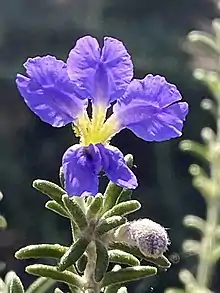| Rosemary dampiera | |
|---|---|
 | |
| Scientific classification | |
| Kingdom: | Plantae |
| Clade: | Tracheophytes |
| Clade: | Angiosperms |
| Clade: | Eudicots |
| Clade: | Asterids |
| Order: | Asterales |
| Family: | Goodeniaceae |
| Genus: | Dampiera |
| Species: | D. rosmarinifolia |
| Binomial name | |
| Dampiera rosmarinifolia | |
Dampiera rosmarinifolia, commonly known as rosemary dampiera,[2] is a flowering plant in the family Goodeniaceae.It is a perennial subshrub with linear leaves, mauve or purple flowers borne in leaf axils.
Description
Dampiera rosmarinifolia is an upright or prostrate perennial subshrub to 60 cm (24 in) high. It has ribbed, needle-shaped stems with whitish branched hairs, often becoming smooth with age. The leaves are linear to elliptic, 9–26 mm (0.35–1.02 in) long and 2–5 mm (0.079–0.197 in) wide, mostly sessile and crowded, often in clusters from the same leaf node, smooth and glossy on upper surface, underside with short, soft hairs and rolled margins. The inflorescence usually with a single flower, up to 3 flowers in upper leaf axils each on a pedicel 3–5 mm (0.12–0.20 in) long. The bracteoles narrowly elliptic, 1–2 mm (0.039–0.079 in) long, sepals 1–1.5 mm (0.039–0.059 in) long and short, matted hairs. The corolla is purple-blue or pink inside, tube about 1.6 mm (0.063 in) long and flattened grey to black hairs on the outside. The posterior lobes are narrowly curved to oblong, 4–5 mm (0.16–0.20 in) long, anterior lobes narrowly lance-shaped, 4–6 mm (0.16–0.24 in) long. Flowering occurs usually August to November and the fruit is egg-shaped, narrower end at the base, grey, hairy and 2–4 mm (0.079–0.157 in) long.[2][3][4]
Taxonomy and naming
Dampiera rosmarinifolia was first formally described in 1847 by Diederich Franz Leonhard von Schlechtendal and the description was published in Linnaea: ein Journal für die Botanik in ihrem ganzen Umfange, oder Beiträge zur Pflanzenkunde.[5][6] The specific epithet (rosmarinifolia) means "rosemary leaved".[7]
Distribution and habitat
Rosemary dampiera grows usually in low-rainfall areas in mallee, scrub and sandy soils in north-western Victoria to the Eyre Peninsula in South Australia.[4]
References
- ↑ "Dampiera rosmarinifolia". Australian Plant Census. Retrieved 10 June 2021.
- 1 2 "Dampiera rosmariniflolia". VicFlora-Flora of Victoria. Royal Botanic Gardens Victoria. Retrieved 10 June 2021.
- ↑ "Dampiera rosmarinifolia". Flora of Australia. Australian Biological Resources Study, Department of Agriculture, Water and the Environment. Retrieved 13 June 2021.
- 1 2 "Dampiera rosmarinifolia". eFloraSA-Electronic Flora of South Australia. State Herbarium of South Australia.
- ↑ "Dampiera rosmarinifolia". Australian Plant Name Index. Retrieved 13 June 2021.
- ↑ von Schlechtendal, Diederich (1847). "Dampiera rosmarinifolia". Linnaea: Ein Journal für die Botanik in ihrem ganzen Umfange, oder Beiträge zur Pflanzenkunde. 20: 603. Retrieved 13 June 2021.
- ↑ Sharr, Francis Aubi; George, Alex (2019). Western Australian Plant Names and Their Meanings (3rd ed.). Kardinya, WA: Four Gables Press. p. 297. ISBN 9780958034180.